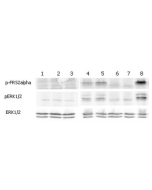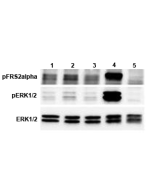Cookie Policy: This site uses cookies to improve your experience. You can find out more about our use of cookies in our Privacy Policy. By continuing to browse this site you agree to our use of cookies.
AdipoGen Life Sciences
FGF-1 (mouse) (rec.) (untagged)

| Product Details | |
|---|---|
| Synonyms | Fibroblast Growth Factor 1; Acidic Fibroblast Growth Factor; Endothelial Cell Growth Factor; ECGF; Heparin-binding Growth Factor 1; HBGF-1 |
| Product Type | Protein |
| Properties | |
| Source/Host | E. coli |
| Sequence |
Mouse FGF-1 (aa 16-155) is untagged. |
| Crossreactivity | Mouse |
| MW | ~16kDa |
| Purity | ≥95% (SDS-PAGE) |
| Endotoxin Content | <0.01EU/μg purified protein (LAL test). |
| Concentration | 0.1mg/ml after reconstitution. |
| Reconstitution | Reconstitute with 100μl sterile water. |
| Formulation | Lyophilized. In PBS containing 0.2 mM DTT. |
| Other Product Data |
Uni-Prot link P61148: FGF-1 (mouse) |
| Shipping and Handling | |
| Shipping | BLUE ICE |
| Short Term Storage | +4°C |
| Long Term Storage | -20°C |
| Handling Advice |
After reconstitution, prepare aliquots and store at -20°C. Avoid freeze/thaw cycles. Centrifuge lyophilized vial before opening and reconstitution. PBS containing at least 0.1% BSA should be used for further dilutions. |
| Use/Stability |
Stable for at least 6 months after receipt when stored at -20°C. Working aliquots are stable for up to 3 months when stored at -20°C. |
| Documents | |
| MSDS |
 Download PDF Download PDF |
| Product Specification Sheet | |
| Datasheet |
 Download PDF Download PDF |
Fibroblast growth factors (FGFs) constitute a family of heparin-binding polypeptides involved in the regulation of biological responses such as growth, differentiation and angiogenesis. The biological effects of FGFs are mediated by four structurally related receptor tyrosine kinases denoted FGFR1, FGFR2, FGFR3 and FGFR4. FGF-1 [FGF-acidic; ECGF; HBGF-1] is a powerful mitogen of cells of mesodermal, ectodermal and endodermal origin. FGF-1 association with heparan sulfate is a prerequisite for activation of FGF receptors. FGF-1 plays a role in various stages of development and morphogenesis as well as in angiogenesis and wound healing processes. Recent data indicate a role of FGF-1 in inflammation and obesity. FGF-1 is selectively induced in fat cells by high-fat diet feeding and established the PPARγ-FGF-1 axis as a critical pathway that regulates adipose tissue remodeling.








